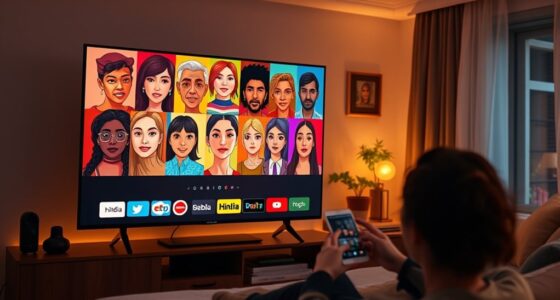Your streaming platform’s algorithm watches how you watch—your history, searches, and pauses—to choose your next binge. It looks for shows similar to what you’ve already enjoyed, aiming to keep you hooked longer. But it can also create a filter bubble, limiting your content variety. Understanding how these suggestions work might help you make smarter choices. If you keep exploring, you’ll uncover even more about how these algorithms shape your viewing habits.
Key Takeaways
- Streaming platforms use algorithms to analyze viewing habits and preferences to generate personalized content recommendations.
- Recommendations are driven by user interactions like watch history, search patterns, and engagement behaviors.
- Algorithms prioritize similar genres or shows to keep viewers engaged and maximize viewing time.
- Bias in data or design can create filter bubbles, limiting content diversity and reinforcing preferences.
- Users can mitigate algorithm bias by actively exploring different genres and manually browsing to diversify their viewing choices.

Have you ever wondered how streaming platforms have transformed the way we watch TV? It’s no longer about flipping through channels or waiting for your favorite show to air at a specific time. Instead, your viewing choices are guided by complex algorithms that analyze your habits and preferences to deliver personalized recommendations. Every time you log in, the platform is working behind the scenes, sifting through vast amounts of data to suggest what you might want to watch next. This personalized approach makes binge-watching easier and more tempting because it feels tailored just for you. The platform learns from your viewing history, search patterns, and even your pause and rewind habits to fine-tune its suggestions. But as much as this personalized touch enhances your experience, it can also introduce a hidden issue: algorithm bias.
Algorithm bias occurs when the system’s underlying data or design skews recommendations in unintended ways. For example, if you tend to watch a lot of action movies, the platform might heavily recommend similar genres, creating a filter bubble. This can limit your exposure to diverse content and reinforce your existing preferences. Sometimes, these biases are subtle, but they shape what you see and, ultimately, what you think is popular or worthwhile. The algorithms are designed to keep you engaged, so they prioritize content that’s more likely to keep you watching longer. That’s why you might notice a steady stream of similar shows, even if you’re interested in exploring different genres or styles. In essence, the platform’s goal is to maximize your viewing time, but that can come at the expense of variety and discovery. Additionally, multi-functional furniture and other space-saving solutions can help create a more comfortable environment for your viewing area, making binge-watching sessions more enjoyable.
You might not realize how much trust you place in these recommendations until you finish a series and wonder what to watch next. The algorithm’s choices often feel intuitive and natural, but they’re driven by data patterns that can sometimes reinforce stereotypes or narrow your perspective. This personalization is empowering, but it’s also important to recognize its limitations. If you’re not careful, you could become trapped in a cycle of similar content, missing out on new genres or voices. Being aware of algorithm bias lets you take control by actively seeking out different kinds of shows or manually browsing categories outside of your usual habits. While streaming platforms aim to serve up content you’ll love, understanding how the algorithms work helps you make more mindful viewing choices, ensuring your binge-watching remains both enjoyable and diverse.
Frequently Asked Questions
How Do Algorithms Predict My Content Preferences Accurately?
Algorithms predict your content preferences accurately by using personalization strategies that analyze your past interactions, searches, and viewing habits. They gather data within privacy guidelines to understand what you enjoy without compromising data privacy. By continuously learning from your behavior, these systems refine their suggestions, ensuring you receive tailored content that matches your interests, making your experience more engaging and relevant every time you log in.
Can I Influence My Recommendations Intentionally?
Ever noticed how your recommendations suddenly change? You can influence them by engaging more with content you genuinely like using personalization techniques. When you actively watch, like, or comment on certain topics, platforms see your preferences clearly and adapt accordingly. Increasing your user engagement helps steer recommendations toward what truly interests you, giving you more control over your viewing experience and making it feel more personalized and satisfying.
Do Algorithms Learn From My Viewing Habits Over Time?
Yes, algorithms learn from your viewing habits over time to improve personalization accuracy. As you watch more content, they analyze your viewing history influence to better understand your preferences. This continuous learning helps platforms recommend shows and movies that align with your tastes, making your experience more tailored. The more consistent your viewing patterns, the more accurately the algorithm predicts what you’ll enjoy next.
Are There Differences in Algorithms Across Streaming Platforms?
You’ll notice that different streaming platforms use distinct personalization techniques to recommend content, reflecting their unique algorithms. Some prioritize your viewing history, while others incorporate user ratings or trending data. Algorithm transparency varies; some platforms clearly explain their processes, while others keep it more secret. This means your recommendations can feel personalized on one platform, but less so on another, depending on how openly they share their algorithms and the data they analyze.
How Private Is My Viewing Data Used for Recommendations?
Your viewing privacy varies depending on the platform, but most collect data to improve your experience. They use your watch history and preferences to make recommendations, which raises concerns about data security. While platforms often claim to protect your data, it’s wise to review privacy policies and settings. You should stay aware of how your viewing data is used, ensuring your viewing privacy is maintained and your data stays secure.
Conclusion
So, next time you hit “Next Episode,” remember it’s not just chance guiding your choice. Algorithms are crafted to keep you hooked, making it seem like your decision. But studies suggest they’re subtly shaping your viewing habits, nudging you toward longer binge sessions. While it feels like your free will, the truth is these platforms are designed to maximize your screen time. Stay aware—your binge-watching habits might be more engineered than you think.










